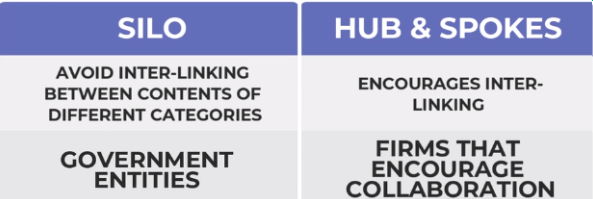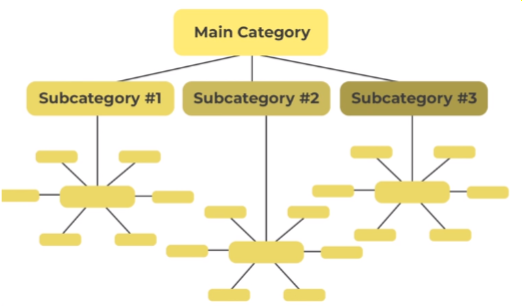Let’s talk about the Content Hub: Hub & Spokes model that most people get confused with the Silo structure, and to be honest, that’s a lot to be confused about because they are very similar.
Table of Contents
ToggleContent Hub: Hub & Spokes Model
Like the Silo Structure, the Content Hub: Hub and Spokes model will have a centralised piece of content and links to other pieces of content in the same category. And, likewise, those pieces of content will link back to the central hub.

Now, the two key differences between the two models are:
- Silo Structure: Content is organised into distinct, hierarchical categories or themes, with each “silo” focusing deeply on a specific topic. This creates clear separation between different topics, and the pages within a silo interlink heavily with each other to reinforce the theme.
- Hub-and-Spoke Model: A central hub page acts as the focal point for a broader topic, with “spokes” linking to supporting subpages or related content. The emphasis is on connecting all related content to the central hub rather than maintaining strict separations between topics.
If you want a simple analogy, the silo Structure is a content hub very like Government Structure where they don’t usually share information with each other. But, the Hubs and Spokes Model is different, it’s a content but very like the high-tech firm that embraces the collaboration of employees from different departments.
A well-structured content database is essential for organizing and managing large volumes of digital assets efficiently.

So, whatever you have learned in the Silo Structure can still be applied to the Hubs and Spokes model. You will still categorise your post in the same way instead of restricting yourself from linking from one article to, and another. You are free to link to any article as long as it makes sense. You have pillar content for each category that works just like the Hubs and Spokes model.
In the real world, there are no perfect Silo Structures and there are no perfect Hubs and Spokes models. It will always be a content hub with a mix of different structures.

Don’t get stressed over having just one structure or the other. The key is to put yourself in the shoes of the visitor.
- Is it easy for your Audience to Navigate?
- How many clicks does your audience need from your Home Page to the article they are looking for.

This is a very short lesson, I hope you understand the similarities and the differences of the Silo and the Hubs and Spokes model. One restricts linking to other pages in another category, while the other promotes it. One is to build topical authority as a whole and the other is to consolidate all the equities to one page.
Conclusion
The silo structure and the hub and spokes model represent two distinct approaches to organizing website content. In the silo structure, the content model is built around tightly focused thematic categories with minimal cross-linking between silos, emphasizing depth within each topic.
In contrast, the hub and spokes model organises content around a content hub—a central page that links to related subpages or “spokes.” While the silo structure creates isolated pathways to enhance topical relevance, the hub and spokes approach fosters interconnectedness, making it easier for users to navigate and explore broader themes while maintaining a cohesive relationship with the content hub.




